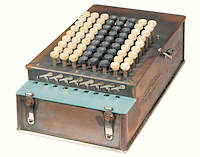 Comptometer Model A, 1904
Comptometer Model A, 1904
 Comptometer Model A, 1904
Comptometer Model A, 1904
|
 The first successful prototype of a key-driven adding machine was
built in Chicago in 1885 by a young mechanic named Dorr E. Felt
(1862-1930, photo c.1920). The
Felt & Tarrant Manufacturing Company was established in 1889 to make
and market the machines under the name "Comptometer". Engineer Joseph
A.V. Turck joined the company around 1910, and led the technical
development through the 1920s and 30s. Turck held over 40 Comptometer
patents (almost as many as Felt himself), and was still active in
retirement in the 1950s.
The first successful prototype of a key-driven adding machine was
built in Chicago in 1885 by a young mechanic named Dorr E. Felt
(1862-1930, photo c.1920). The
Felt & Tarrant Manufacturing Company was established in 1889 to make
and market the machines under the name "Comptometer". Engineer Joseph
A.V. Turck joined the company around 1910, and led the technical
development through the 1920s and 30s. Turck held over 40 Comptometer
patents (almost as many as Felt himself), and was still active in
retirement in the 1950s.
The primary aim of the Comptometer was fast and accurate addition, from which all other calculations could be derived. Addition is performed directly, just by pressing the keys. Subtraction is performed by the addition of complements, using a second set of (smaller) numbers marked on the keys. Multiplication is performed by a simple procedure involving repeated additions. Division is a more complex procedure, and is sometimes converted into a simpler multiplication using a table of reciprocals.
Speed was addressed through direct key-driven operation, with no need for separate actuating cranks or levers. Felt's "Duplex Comptometer" of 1904 allowed keys in adjacent columns to be operated simultaneously rather than sequentially, so that multi-digit numbers could be entered in one stroke using the fingers of both hands. A power-assisted mechanism with an electric motor drive (similar to an electric typewriter) was introduced in the Model K in 1934.
Accuracy was addressed through the basic design of the mechanism, which prevented the registration of incomplete keystrokes. The Model E of 1913 introduced an elaborate "Controlled Key" mechanism which detected such errors and locked the machine until they were corrected. Other potential errors were eliminated when a "start-from-clear" signal was added to the Model H in 1920, and leading-zero suppression was added to the Model M in 1939. Almost one-quarter of the mechanism of the "Controlled-Key" Comptometer was devoted to error prevention and correction.
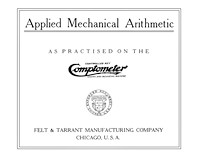 Similar attention to detail was given to the operating procedures
and instruction manuals that Felt prepared for the owners and operators
of his machines. A 600-page illustrated treatise on "Applied Mechanical
Arithmetic" addressed every conceivable business and commercial
calculation and showed how it could be accomplished with minumum
effort on the Comptometer. The illustration shows the title page of
the 1920 revised edition. Comptometer schools were set up to teach
these new methods, and
"Comptometer operator"
soon became an established profession.
Similar attention to detail was given to the operating procedures
and instruction manuals that Felt prepared for the owners and operators
of his machines. A 600-page illustrated treatise on "Applied Mechanical
Arithmetic" addressed every conceivable business and commercial
calculation and showed how it could be accomplished with minumum
effort on the Comptometer. The illustration shows the title page of
the 1920 revised edition. Comptometer schools were set up to teach
these new methods, and
"Comptometer operator"
soon became an established profession.
In spite of its external simplicity, the mechanism of a key-driven calculator contains a great many unexpected subtleties. It is a tribute to Felt's achievement that no significant alternative to his Comptometer appeared until 1912 in the USA and the 1930s in England.
Felt was also the first to develop a practical printing or recording calculator, which was sold under the name "Comptograph" from 1889. The Comptograph never had the success of the later Burroughs adding and listing machine, and was discontinued in the 1920s. Several of Felt's Comptograph patents were licensed to others (including Burroughs), and eventually formed the basis of the "accounting machine" industry.
Felt & Tarrant became a publicly-listed company in 1947. The name was changed to Comptometer Corporation in 1957 as a new management team set out to modernise and diversify the one-product company. The traditional product line suffered, and by the late 1950s the Comptometer Corporation was in serious trouble.
In 1957 the British rights to the Comptometer name were sold to the Bell Punch Company, a long-time rival in the Commonwealth markets. When manufacturing in Chicago ended shortly afterwards, re-badged Bell Punch machines were imported to the USA for sale as new-model Comptometers.
The Comptometer Corporation was absorbed into the Victor Adding Machine Company in a "merger" in 1961. The new Victor Comptometer Corporation expanded into the 1970s with electronic calculators, cash registers, and computers. Its descendants are still active in the calculator business as Victor Technology.
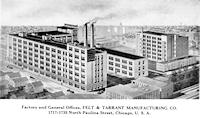 The Felt & Tarant factory in North Paulina Street was erected in 1908,
and was extended several times into the 1950s. The illustration shows
the factory and general offices as they appeared in about 1920. The
main building still stands as a Chicago landmark. During the 1980s the
building was used as the Paulina Arts Centre (PAC), and by 2010 it
was being converted into
high-class condominiums known as the PAC Lofts.
(More PAC photos courtesy of Lucid Realty, Chicago).
The Felt & Tarant factory in North Paulina Street was erected in 1908,
and was extended several times into the 1950s. The illustration shows
the factory and general offices as they appeared in about 1920. The
main building still stands as a Chicago landmark. During the 1980s the
building was used as the Paulina Arts Centre (PAC), and by 2010 it
was being converted into
high-class condominiums known as the PAC Lofts.
(More PAC photos courtesy of Lucid Realty, Chicago).
This page describes a selection of Comptometers manufactured by Felt & Tarrant and their UK subsidiary. Please see the Bell Punch Company page for the later "Sumlock" machines with Comptometer nameplates.
Click on the photos for larger illustrations.
The Comptometer was a key-driven adding machine operated directly by the pressure of the operator's fingers on the keys. It was generally available with 8, 10, or 12 keyboard columns, although larger machines were made with 16 or even 20 columns. The result register always had one additional place to the left of the key columns, so that a multiplication could be started at the left of the keyboard.
The machines were made in decimal and several non-decimal arrangements, including Sterling and Indian currencies and Imperial lengths and weights.
The model numbers refer only to the design of the internal mechanism, and do not indicate the number or denomination of the columns.
 Felt & Tarrant Comptometer, Model A, S/N 20321
Felt & Tarrant Comptometer, Model A, S/N 20321
8/9 columns, decimal currency
Dimensions: 8"W x 14-1/2"D x 6"H
Weight: 15 pounds
Manufactured: Chicago, USA, 1904-1906
Original Owner: Adelaide Tramways Trust (ex H.A.Weaver collection).
Felt & Tarant's first "production" machines (1899-1903) were housed in wooden cases, and were known simply as "Comptometers" without a model designation. The early mechanism required the keys to be operated one-at-a-time, which was less than ideal for performing multiplication and division. The Model A "Duplex Comptometer" from 1904 added a new automatic mechanism which allowed keys in adjacent columns to be pressed simultaneously, so that multi-digit multipliers and divisors could be entered at a single stroke using the fingers of both hands.
The Model A is housed in a rectangular metal case with classical scrollwork decorations embossed into the side panels. The register cover is made of frosted glass, with clear viewing windows for the numeral wheels below. ("Fuzzy" window borders are not a Microsoft invention - the Comptometer had them in 1904). Decimal indicators can be swung down between the digits as required. The small tabs protruding just above the register windows are the "subtraction cut-off levers", which avoid the need to left-fill the keyboard with 9s when subtracting by addition of complements. The clearing handle on the right-hand side is moved rearwards and back again to return the register to zero. The clamps and thumbscrews on the front of the machine allow the glass cover to be removed easily for lubrication.
This 8-column decimal machine was purchased by the Tramways Trust
in the city of Adelaide in about 1905. It was the first Comptometer
to be sold in the state of South Australia, and is still in good
working order after more than a hundred years.
Model A register detail.
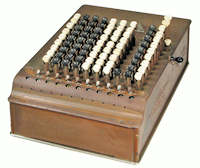 Felt & Tarrant Comptometer, Model E, S/N 57641
Felt & Tarrant Comptometer, Model E, S/N 57641
10/11 columns, Sterling currency (without farthings)
Dimensions: 9-1/2"W x 14-1/2"D x 6"H
Weight: 21 pounds
Manufactured: Chicago, USA, 1913-1915
The Model E "Controlled-key Duplex Comptometer" from 1913 was the first machine to incorporate an automatic mechanism to detect and correct incomplete keystrokes.
If the operator releases a key before it has been fully depressed, the keys in all the other columns will immediately lock. The operator must stop, complete the incorrect keystroke, and clear the lock by pressing the single white button at the right-hand side. She can then continue with the calculation as if nothing had happened. The locking is controlled by an elaborate "trigger" mechanism in each column, which is armed and dis-armed on every keystroke.
Errors due to incomplete upstrokes (ie, repeating a keystroke before the key has fully risen) are eliminated by means of an automatic ratchet locking mechanism which engages as the key rises. The key can not start down again until the lock is reset at the top of the return stroke.
The Model E was also the first (and only) Comptometer to have interference guards fitted to the sides of the keys. A perceived problem with the trigger mechanism was that it might be activated accidentally if the operator's fingers brushed the side of an adjacent key. Such an event would not normally register as a keystroke, but it might be sufficient to activate the safety mechanism and lock the machine. To prevent un-necessary lock-ups and delays, the keys were fitted with metal guard plates on each side. If the key was struck centrally it would register normally, but if struck on the side the guard would lock the key and the trigger would not operate. Refinements to the trigger mechanism made the interference guards un-necessary, and they were deleted in the next model.
The illustration shows a 10-column Model E for Sterling currency,
without farthings. The 10 and 11 pence keys do not have the
interference guards, as there are no adjacent keys.
Model E keyboard detail showing interference guards.
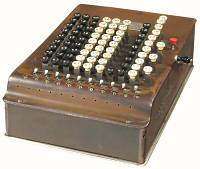 Felt & Tarrant Comptometer, Model F, S/N 143369
Felt & Tarrant Comptometer, Model F, S/N 143369
10/11 columns, Sterling currency
Dimensions: 9-1/2"W x 14-1/2"D x 6"H
Weight: 20 pounds
Manufactured: Chicago, USA, 1915-1920
The Model F Comptometer followed on from the Models A to E in 1915. It was the first model to be mass-produced in quantity, with more than 40,000 units built over a 5-year period. The machine is generally similar to the Model E, but with a re-calibrated "Controlled-key" trigger mechanism and without the keyboard interference guards.
The illustration shows a 10-column Model F for Sterling currency, with farthings.
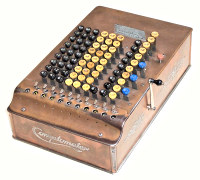 Felt & Tarrant Comptometer, Model H, S/N 254819
Felt & Tarrant Comptometer, Model H, S/N 254819
10/11 columns, Sterling currency
Dimensions: 9-1/2"W x 15"D x 6"H
Weight: 21 pounds
Manufactured: Chicago, USA, 1920-1926
A 10-column Model H Comptometer for Sterling currency, with the classic "Comptometer" name embossed into the front of the case.
The Model H made significant changes to the clearing mechanism to further reduce the chance of error. Operators making perhaps 200,000 keystrokes and 3000 clearings per day would sometimes fail to clear the machine before starting a new calculation, and would be unaware of their mistake. The Model H Comptometer introduced a "start-from-clear" signal which provided threee separate indications - visual, audible, and tactile. The clearing handle was relocated to a more convenient position near the front of the machine, and needed only to be drawn lightly forward and released. After clearing, the zeros in the register were offset slightly to give a visual confirmation of the machine's state. The first keystroke of the next calculation required a firmer pressure, corrected the zeros, and rang a small bell, thus providing three separate signals to verify that the calculation was starting from clear.
Felt & Tarrant made much of the term "Enforced Accuracy" in their advertising, as it was impossible to be unaware of an operating error.
The mechanical changes needed to provide the clearing signals are described in US Patent 1357748, filed by engineer J.A.V.Turck in 1919. The escapement mechanism was redesigned and mounted in a hinged sub-frame, which was controlled by two over-centre toggle mechanisms triggered alternately by the keys and the clearing handle. The sub-frame could be removed relatively easily, which greatly simplified cleaning and adjustment. The front of the case was lengthened by half an inch to accommodate the new mechanism.
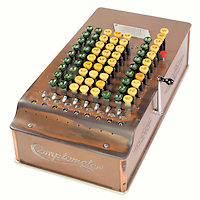 Felt & Tarrant Comptometer, Model J, S/N 299982
Felt & Tarrant Comptometer, Model J, S/N 299982
8/9 columns, Sterling currency
Dimensions: 11"W x 15"D x 6"H
Weight: 25 pounds
Manufactured: Chicago, USA, 1926-1939
The Model J Comptometer from 1926 made only minor changes to the very successful Model H. The springs were re-calibrated to provide a lighter touch, some detail changes were made to the tens-carry mechanism, and the accumulator latches were re-designed to improve the reliability of the clearing operation. The colour of the dark keytops changed from black to green to reduce contrast and eye strain. The illustration shows an 8-column Model J for Sterling currency, without farthings.
8-column machines are rather rare in Sterling configurations as they had insufficient decimal columns for general use in multiplication or division. They were entirely satisfactory for add-only applications, but there were cheaper alternatives available. Most of the Comptometers sold in Australia were general-purpose 12-column versions.
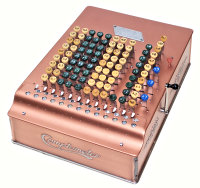 Felt & Tarrant Comptometer, Model J, S/N 254299
Felt & Tarrant Comptometer, Model J, S/N 254299
12/13 columns, Sterling currency
Dimensions: 11"W x 15"D x 6"H
Weight: 25 pounds
Manufactured: Chicago, USA, 1926-1939
This illustration shows an early 12-column Model J for Sterling currency, originally used in the accounts department of a firm in Adelaide, South Australia.
The "copper-cased" Comptometers were never intended to have this bright copper finish. Rather, the copper plating was used as an undercoat, as zinc plating or galvanising is used today. The copper protected the steel, and provided a base for a light-brown translucent lacquer finish. Both layers are generally worn through to the bare steel on the corners and around the clearing handle. Cleaning must be done carefully to avoid producing patches of bright copper where the lacquer has deteriorated. The machine illustrated has had all of the old lacquer removed, and the copper has been cleaned to a dull finish. While it may look distinctive, it is certainly not authentic.
Some of the moulded keytops on this machine can be seen to be in poor condition. The black and white keys on the older models are usually still in good order after more than 100 years. The white keys on the later models are often severely yellowed, shrunken, or brittle, while the new green keys on the Model J have sometimes decomposed into an oily mess. These problems with new synthetic materials are not unique to Comptometers, nor are they limited to the polymer science of the 1920s. Many relatively modern materials (such as the nylons and polyurethanes of the 1960s and 70s) have been introduced with great promise, but have proven to be total failures in long-term service.
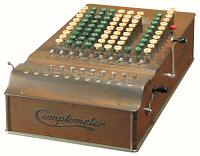 Felt & Tarrant "Super Totalizer" Comptometer, Model S,
S/N J321777-S1625
Felt & Tarrant "Super Totalizer" Comptometer, Model S,
S/N J321777-S1625
10/11 columns, dual register, Sterling currency (no farthings)
Dimensions: 9-1/2"W x 18"D x 6"H
Weight: 27 pounds
Manufactured: Chicago, USA, 1934-
A ten-column dual-register Comptometer for Sterling currency, without farthings.
The "Super Totalizer" is essentially a standard Model J Comptometer with a second accumulator register added at the front. The front register can be engaged and cleared independently, so as to accumulate the grand total of a series of calculations. The front of the case has been extended by 3 inches to accommodate the additional mechanism.
US Patent 1391220 for an early dual-register Comptometer was issued to J.A.V.Turck in 1921. The machine illustrated was introduced in 1934, and is based on a much later patent (2130364) to Turck and Niemann. The machine carries separate serial numbers for the main machine (J321777) and the front register mechanism (S1625).
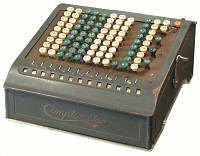 Felt & Tarrant Comptometer, Model K, S/N 381650
Felt & Tarrant Comptometer, Model K, S/N 381650
12/13 columns, Sterling currency, electric
Dimensions: 12"W x 13"D x 6-1/2"H
Weight: 24 pounds
Manufactured: Chicago, USA, 1934-1950
The Model K was the first electrically-operated Comptometer, also introduced in 1934. The machine still responds immediately to the keys, but the power to drive the mechanism is now provided by an internal electric motor rather than by the operator's fingers. The principle is similar to an electric typewriter, and results in a very light touch for the operator. (Models F to J required more than 1 pound force to operate the keys. Models A to E required up to 5 pounds).
The internal mechanism of the Model K combines the well-proven register and tens-carry mechanism from the Model H with an all-new keyboard and actuating mechanism. The machine replicates the "controlled key" locking mechanism, which functions in exactly the same manner as on the manual machines - a remarkable engineering achievement, considering that the internal keyboard mechanisms are completely different.
The Model K is housed in a pressed-metal casing with a dark chocolate-brown painted finish. The case is raised at the rear to give a sloping keyboard with a uniform key height. The 10 and 11 pence keys on this Sterling-currency model have been moved sideways into the top of the farthings column.
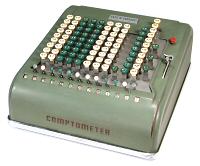 Felt & Tarrant Comptometer, Model M, S/N 506859
Felt & Tarrant Comptometer, Model M, S/N 506859
12/13 columns, Sterling currency
Dimensions: 12"W x 14-1/2"D x 6"H
Weight: 23 pounds
Manufactured: Chicago, USA, 1939-1950
The Model M manually-operated Comptometer, which followed the Model J in 1939, had a more rounded pressed-metal casing with a mid-green painted finish. The machine is an inch wider than the corresponding Model J, with the clearing handle located within the limits of the body rather than externally.
The mechanism of the Model M was similar to the Model J, but
included a number of changes which provided a lighter touch than
on the earlier machines. It also introduced a latching mechanism on
the subtraction buttons, and a new mechanism which aimed to reduce
reading errors by
supressing the
display of leading zeros in the accumulator. The mechanism uses
modified numeral wheels with cascaded shutters to hide the
unwanted zeros.
Model M supressed-zero display.
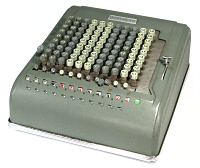 Felt & Tarrant Comptometer, Model 3D11, S/N 20221
Felt & Tarrant Comptometer, Model 3D11, S/N 20221
12/13 columns, Sterling currency, converted to decimal
Dimensions: 12"W x 14-1/2"D x 6"H
Weight: 20 pounds
Manufactured: Chicago, USA, 1950-1961 (approx)
Model 3D11 was the last of the Felt & Tarrant manual Comptometers. It followed on from the very successful Model M in 1950, and continued until the end of US production in Chicago in 1961.
A new feature of this model is the single key on the left-hand side which is marked with multiplication and division symbols. When latched down, this key modifies the operation of the "controlled key" mechanism so that it resets automatically when the errant keystroke is completed. This was especially useful in multiplication and division calculations, as it meant that the operator did not have to re-position her hands to correct the error. The red "controlled key" release button was also relocated to become a small green button amongst the subtraction cut-offs at the front of the machine.
This 12-column machine was originally built for Sterling currency. It was converted to 11-column decimal by the Australian agents (Peacock Bros) during the decimal currency change-over in 1966. This was not a trivial process, as it required removing the keys and key-plate, punching new key slots in the ten-shillings column, filling the empty slots in the pence and farthing columns, and disassembling the frame to replace the special side plates in the ten-shillings column.
After the 1939-45 war, the British government imposed various tarrif and local-content requirements to protect local industries during the reconstruction period. In the case of calculators, the existence of the Bell Punch Company's new key-driven machines presented a barrier to further direct imports of Comptometers.
The import restrictions led Felt & Tarrant to establish a subsidiary company to assemble Comptometers in the UK, initially using parts from the Chicago factory and later from local manufacturers. The British operation was profitable, but was dissolved when the Comptometer Corporation finally surrendered to the Bell Punch Company in the late 1950s. Comptometer Corporation ceased production in Chicago shortly afterwards, and began importing re-badged Bell Punch machines for sale as new-model Comptometers.
This section shows a few of the machines from Felt & Tarrant's UK subsidiary. The later Sumlock machines with Comptometer nameplates are shown on the Bell Punch Company page.
 Felt & Tarrant Comptometer, Model J, S/N 313931
Felt & Tarrant Comptometer, Model J, S/N 313931
12/13 columns, decimal, refurbished
Dimensions: 11"W x 15"D x 6"H
Weight: 25 pounds
Manufactured: Chicago, USA, 1926-1939, refurbished 1966
There was a significant trade in refurbished Comptometers in
post-war England due to the import restrictions, and again in Australia
around the time of the decimal currency conversion in 1966. Although
nearly 40 years old at the time, this 12-column Model J was converted
to decimal by the local agents and re-finished in the new Comptometer
green. The machine has also been fitted with a new set of 1950s
3D11-style keys, suggesting that the problems with the original
synthetic keys were already evident.
F&T UK advertisement for rebuilt Comptometers.
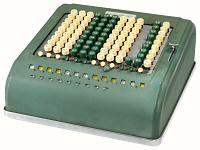 Felt & Tarrant Ltd Comptometer, Model 992, S/N 23898
Felt & Tarrant Ltd Comptometer, Model 992, S/N 23898
12/13 columns, Sterling currency (no farthings), electric
Dimensions: 13"W x 14"D x 6"H
Weight: 25 pounds
Manufactured: Felt & Tarrant Ltd, London, England, 1950s
The motor-driven Model 992 was introduced in 1950 to update the Model K with some of the features from the later manual machines. The case is similar in style to the 3D11, with the clearing handle inboard and the controlled-key release button at the front. The register incorporates the leading-zero shutters and latching subtraction buttons from the Model M. A new electrical switching arrangement starts the motor automatically when a key is pressed, rather than having it run continuously.
Although built in the UK for Sterling currency, the machine has
no farthings keys and no 10 or 11 keys in the pence columns. The 10
and 11 keys were rarely used for addition, and their absence presented
only a minor complication when subtracting by complements.
Felt & Tarrant Ltd patent label
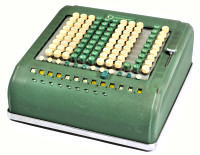 Felt & Tarrant Ltd Comptometer, Model 99C, S/N 40593
Felt & Tarrant Ltd Comptometer, Model 99C, S/N 40593
12/13 columns, Sterling currency (no farthings), electric
Dimensions: 13"W x 14"D x 6"H
Weight: 25 pounds
Manufactured: Comptometer (Great Britain) Ltd, London, c.1960
Model 99C was a minor update to reflect the company name change to Comptometer Corporation in 1957. This 12-column Sterling machine is externally identical to the 992 above, except for the new green Comptometer badge behind the keys and the patent label underneath.
The mechanism was also updated to use a new synthetic material
(nylon?) in the compensators. (The compensators are friction clutches
which adapt the fixed stroke of the powered actuator to the variable
travel of the keyboard mechanism). The new material was not a success,
to the extent that most 99C machines had to be converted back to the
previous oiled felt compensators.
Comptometer (Great Britain) Ltd patent label.
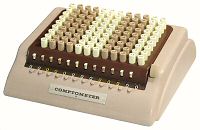 Bell Punch Comptometer, Model 12B, S/N 951085 F
Bell Punch Comptometer, Model 12B, S/N 951085 F
Please see the Bell Punch Company page for the British-made "Sumlock" machines with Comptometer nameplates.
 Felt & Tarrant letterhead, 1928.
Felt & Tarrant letterhead, 1928.
A lithographed letterhead from some Felt & Tarrant head office correspondence from 1928. (Click images to enlarge).
This high-class identity badge was issued to workers at the Felt & Tarrant factory in Chicago. It measures about 35mm high and wide and is about 2mm thick. The Comptometer name and shield are coloured with blue and white vitreous enamel. The badge was made by Bastian Bros. of Rochester, NY.
Comptometer badges and rings were presented to operators who achieved exceptional results in their examinations or in subsequent employment. The lapel badge is quite discreet, measuring only 10 x 12mm. The Comptometer ring has a small presentation case which measures 40 x 45 x18mm.
The leak-proof metal oil can supplied with each Comptometer was originally designed "particularly for the use of bicyclists" by John Lines of the Scovill Manufacturing Company. It is described in US Patent 554941 from 1896. The deep-drawn body is in one piece, with a separate top, spout, and cap. The body measures 25 x 12 x 50mm approx, with a total height of 90mm. The Comptometer name is embossed along each of the narrow sides.
Many businesses used various sorts of give-aways as incentives or rewards for customers. This "pocket calendar" card (58 x 96 mm) from 1938 shows the then-current manual Model J and the electric Model K. The J was replaced by the Model M in 1939, but the K continued until 1950. The printed images on this well-preserved card are a good representation of the colour schemes as they were originally manufactured.
This double pack of Comptometer playing cards was used to promote the new 1950 models. The manual Model 3D11 is shown on the red-bordered cards, and the electric Model 992 on the blue. Both models were released in April 1950.
Early-model Comptometers were supplied with a substantial
sheet-metal dust cover with the name printed on both ends.
The fine print reads:
COMPTOMETER
(pronounced like thermometer)
Detail view (29kb)
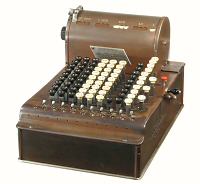 Attachment for multiplication in Sterling currency
Attachment for multiplication in Sterling currency
Dimensions: 8"W x 4-1/2"D x 4-1/2"H
Weight: 3 pounds
Manufactured: Chicago, USA, 1909-
This attachment contains a look-up table to assist the operator in calculations involving Sterling currency, especially in multiplications where the amounts are first converted into pence.
The device clamps on to the flat section at the rear of the early Comptometers, but has no connection to the internal mechanism. The printed table has 48 rows for pence and farthings from 0 to 12, and five columns for multipliers of 1, 10, 100, 1000, and 10,000. The table is wrapped around a drum of 4" diameter, which can be turned to any of 48 positions by the knob at the left-hand end. The multiplier is selected by a lever at the top left, which opens a shutter to reveal the desired column. The drum is turned to show the pence value in the rightmost window, the lever is set to the multiplier, and the result in £-s-d is read from the open window. Successive lookups for tens, hundreds, etc can be added on the keyboard to give the final total.
The British copyright for the table was entered at Stationers' Hall
in 1909.
Separate view (25kb)
Scale detail (underneath view) (29kb)
Nameplate with UK patents (26kb)
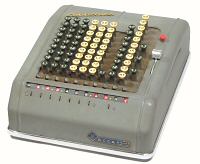 Addicalco Model 53, S/N 103186
Addicalco Model 53, S/N 103186
Digits: 10 keyboard, 11 accumulator, Sterling (with farthings)
Dimensions: 285W x 380D x 155H
Weight: 9.48kg
Manufactured: ACCA, Milan, Italy, 1950s
The Addicalco was built by the firm ACCA (loosely translated as "Adding, calculating, accounting, etc.") in Milan from 1946. The first machines were built using a set of tooling from Felt & Tarrant's superseded Model J Comptometer, presumably supplied as part of the post-war European reconstruction program.
This Addicalco Model 53 is a 10-column machine for Sterling currency
(with farthings), in a one-piece metal casing similar to the Model M
Comptometer. It was imported and sold in Australia in competition with
the Comptometer, but only in fairly small numbers. This machine has a
leather carrying case that was custom-built by a firm in Melbourne.
Addicalco badge (24kb)
ACCA badge (24kb)
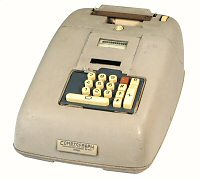 Comptograph, Model 101, S/N 107045 C
Comptograph, Model 101, S/N 107045 C
Ten-key, printing, decimal
Dimensions: 10-1/2"W x 17"D x 7"H
Weight: 21 pounds
Manufactured: Walther, Germany, 1950s
In the 1950s the Comptometer Corporation sought to broaden their product line with a ten-key adding and listing machine sourced from Walther in Germany. The name "Comptograph" was taken from Felt's original recording calculator of 1889.
When the Comptograph was discontinued in favour of the Victor machines following the merger in 1961, the Australian Comptometer agents continued to supply the Walther machines direct from Germany.
 Comptometer Decoration
Comptometer Decoration
Part of the decorative scrollwork which is embossed into the sides of the early Comptometer cases.

The classic Comptometer script trade mark, embossed into the front panel of the Model H and J cases.
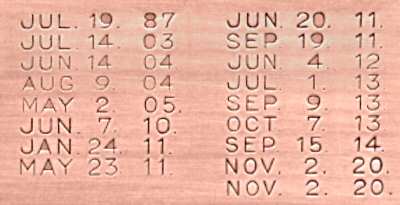 Comptometer Patents
Comptometer Patents
The rear panel of the Model J Comptometer shows a series of US patent dates, from the first production model in 1887 up to the introduction of the Model H in 1920.
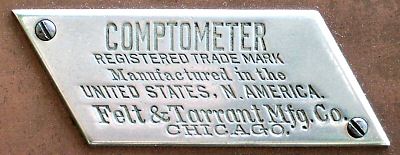 Comptometer Nameplate
Comptometer Nameplate
The engraved nameplate fastened to the top of the "copper-cased" Comptometers (1904-1939), just behind the keys. The "Registered Trade Mark" line did not appear until the Model H in 1920.
 Models K and M Badge
Models K and M Badge
Models K and M (1939-1950) have the Comptometer name embossed into the front panel, with a small die-cast "Felt & Tarrant" name badge behind the keys. The engraved nameplate with the "back-handed" text still exists, but it has been banished to the underside of the case.
 Early 3D11 Badge
Early 3D11 Badge
The early Model 3D11 machines (c.1950) have a plain painted casing, with the "Comptometer" name appearing only on the small badge behind the keys.
 Late-model 3D11 Badge
Late-model 3D11 Badge
A re-styled Comptometer badge in plastic rather than metal, from one of the last Chicago-built machines. The grey colour matches the keytops. The Comptometer name is painted in the same style in silver on the rear of the machine.
 UK Comptometer Badge
UK Comptometer Badge
A similar Comptometer badge from a British-made Felt & Tarrant machine.
 Comptograph Badge
Comptograph Badge
The Model 101 Comptograph from the 1950s uses an inverted version of the same badge on the front of the machine. It refers to "Comptometer Ltd (Great Britain)", and carries the ribbon logo of the German Walther company.
 The Australian agents
The Australian agents
Peacock Bros. was a long-established firm of specialist printers and office systems suppliers based in Melbourne, Australia. Over the years they handled the Swiss "Millionaire" and "MADAS" calculators, the American "Comptometer", the German "Walther" ten-key machines, and eventually the Japanese "Busicom" electronic calculators. The firm is still in business, primarily in labelling and identification systems, and recently celebrated its 120th anniversary.